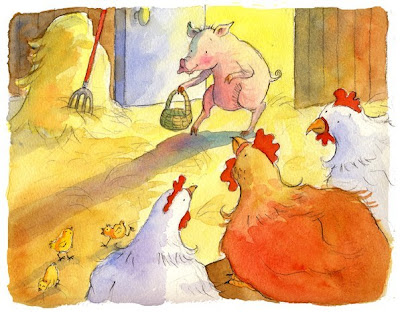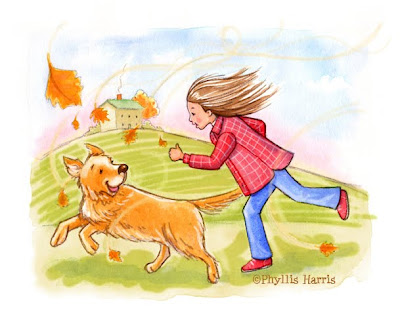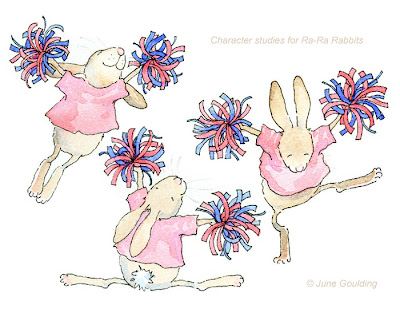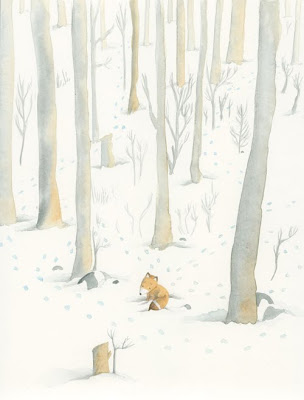___________________________________________________________
This is written for people just starting out in the business. Everyone's been there, you have a dream but have no idea where to start. I've written some quick, simple, to the point steps to guide you in the right direction. Following these steps are more helpful tips and comments added by fellow illustrators: Ginger Nielson, Kim Fleming, Phyllis Harris, June Goulding, Alicia Padron, Mai Kemble, and Woody Miller! Many thanks to these wonderful artists for taking the time out of their busy schedules to participate!
_________________________________________
Paige Keiser:

1. Practice a lot and study illustrators you admire
2. Create a strong portfolio of 8 - 10 pieces (kids, animals, and family scenes are typical subjects, but whatever inspires you is what you should draw!)
3. Create a website with your portfolio and contact information. A lot of people pay a professional web designer for this. I simply used iweb because I like to update my portfolio a lot and it would get expensive paying someone to do that each time.
4. Create a postcard with your website address, contact info and your best image and send it out to publishers who publish books similar to your art style (2010 Writers and Illustrators Market book is a must--contains detailed publisher's contact information and articles about getting started.)
5. (optional) submit printed samples of your portfolio to an agent. Agents do all that 'businessey' stuff (that I'm not only bad at, but fact of the matter is I would rather be drawing than printing out invoices, making calls, etc etc). They also go to bat for you if a deal turns bad or someone doesn't pay. And if you're lucky, they turn out to be really great friends as well :0) Typical cut that an agent takes is 25%. This is all personal decision of course, some people enjoy the business side of things and like being in complete control of every detail. There's no right or wrong decision!
There are lots of other things you can do, but the above is where you should start. Portfolio portfolio portfolio - you can't repeat that enough to yourself because it's everything--it's what represents you. Once you have a good one, promote till your computer fries--blogging, childrensillustrators.com, picturebook.com, vistaprints.com. Also go to the local SCBWI (Society of Children's Book Writers and Illustrators) conferences and meet those publishers face to face!
Good luck, it's a jungle out there!
And now to continue, here are some extra tips from a few pros in the field:
____________________________________________________
Phyllis Harris:

Gosh, where do I begin?
First, do a lot of seat time on the internet. It has been the root of my education on the whole business of children's book illustration.
Second, always work on your craft. Draw, draw, draw. Paint, paint, paint. I continue to learn and grow daily. I look back on my first projects/jobs and wonder how I ever got hired?! But this is where persistence and patience also paid off. Gotta have those... persistence and patience!
Get a copy of the 2010 Children Writer's and Illustrator's Market published by Writer's Digest Books. Send your art samples out to art buyers via mail(postcards and mailers) and direct them to your online portfolio on your website. Website...gotta have one to promote yourself with an online portfolio and contact info.
For those who are still in school--take every opportunity available to network with editors and art buyers at publishing houses and magazines. Getting on as an intern is probably the best opportunity out there!!!
____________________________________________________________
Ginger Nielson on Digital Illustration Tips:

1.) My transition from traditional art to digital art was one that took a good deal of time and choosing the right program for me. Many have asked which or how many digital art programs they might need to learn.
I believe that if you find ONE program that you are comfortable with you should take the time to learn it and learn it well. The time you spend becoming proficient in your chosen software will pay you back. There is a great deal of depth to the high end programs,(Photoshop, Illustrator, Painter) and if you are an illustrator, you really only need one that 'fits' you.
Common sense dictates that you need a good working digital tablet and pen if you plan to create digital images. Wacom is the best and there is a whole range to fit almost any budget.
2.) On a merely practical note.... if you are a digital illustrator you MUST constantly "Save" the piece you are working on. A power outage, or program crash can wipe out hours of work. As many times as I say this, I have still suffered the loss of huge chunks of work because I forgot to save, save, save.
3.) Digital artists who work in layers in photoshop or painter should also save at least one version of their artwork as a full set of separate layers. You can drop the layers , give the piece an alternate name and save that as well. But, the fact that you still have a file with all the various layers separated will make any editorial changes much less stressful.
4.) I keep a digital file folder of the sketches, layered files and any reference material for any assignment I am given. When the assignment is turned in and the contract has been fufilled, I move the entire folder to an external hard drive for future reference.
5.) I also maintain a Digital File Cabinet. It is set up as if it were in my desk drawer, with categories for all the sketches, reference materials and finished artwork I have created. This is also kept on an external hard drive with a huge amount of storage space. It frees up my main computer and allows me to work faster and more efficiently.
____________________________________________________
Kim Fleming:

I guess I would say “put yourself out there” because that’s the only way you will get out of your living room. So make a blog, a website, get involved with group projects, call publishers and set up appointments to view your folio (it’s not as scary as you think). Some illustration portfolio websites can be really good, but do your research. I’ve found that the majority of my work has come from meeting face-to-face with a publisher, and then word of mouth from there.
Some tips for a good folio: less is more. Don’t think that because you have 30 average pieces in your folio that that is impressive – it is much better to have 15 strong pieces than 30 mediocre ones. Start strong and finish stronger. Don’t put anything in your folio that you don’t actually enjoy doing – even if you are good at it – because that is most likely going to be the chosen style for you to do 398 illustrations. But something editors do like to see is that you can draw characters consistently, so one character in several different poses can be really good. You may also like to like about showing movement, perspective and emotion in your characters and scenes.
Also I would say “be true to yourself” in what you do. This can be really difficult when you don’t know what that is! But if you practice, and experiment, and do what you really love, then that will be your best work in the end anyway, and you will find your voice along the way.
Good luck!
______________________________________________________
Mai S Kemble:
2. Website- use blogger if you have to, but you must have something on the internet that has your portfolio
3. Join jacketflap, scbwi, and try to use other sites to network and gain insight/advie/critique from others in the field
4. Always compare yourself to professionals that already are published-don't stay in a hole or you will never improve- (and always try to improve)
5. You must submit your stuff- that said- do your research!! (internet, book stores have sections on publishers- get the CWIM!!!!! every year!!!! read the whole thing and study it!!!)
6. Submitting- make sure you look professional! try to create an overall look for your work. :)
7. Read and love children's books! collect them, study them, and cherish them- they will save you at times you wouldn't expect or realize!
8. Believe in yourself!! good luck!!!
______________________________________________
June Goulding talks about portfolio specifics:

I agree with all that has already been covered, but I would like to add...
...Practice creating a character and showing them sequentially in different situations, as you would find in a picture book. You need to reassure a publisher that you can draw a character in many poses and perspectives, not just from a front or side view.
You will need to be able to convey movement and emotions through a character's body posture and expressions.
You also need to show that your 'style' will remain constant throughout the book, even though you may not paint the pages in sequential order. Some pages may use spot illustrations whilst others will fill with colour right up to the trimmed edges. All of the illustrations need to work together to create a smooth story-flow through the book.
And remember, if you enjoy what you are doing, it will show in the final art.
________________________________________
Alicia Padron:

I don't have the experience of many years in this career, but I can add my 2 cents :o)
Do
* Believe in yourself and your art. If you don't like it people won't either. Trust what you do and try your best at it.
* Practice, practice and did I say.. practice? Draw a lot. From real life, from references in books, from your imagination.
* Try to find a style. This is not easy, I know. I'm sure people say it all the time like everybody knows a magic formula as to how to get one. There is no formula, but what I think is the best way to approach it is by practicing so much and closing your eyes and thinking what it is you REALLY want to draw. Is it animals? Kids? Pirates? Then do it... and after a while a pattern will appear. You'll see some similarities to them and that is the style emerging. Also I think that style is linked to what you enjoy the most doing.. Usually you have more confidence and a looser hand at that so the style will come easier through this.
* Read all you can about it. The art side and the business side too. Buy books and read articles in the internet.
* Subscribe to the SCBWI. It is a great way to learn about this business. Read the forums and ask questions. Try to attend conferences, you get to meet many interesting people in the field and learn from all the wonderful speakers.
* Work on a portfolio. When you "find" your style, work on having 10 to 15 really good pieces for your portfolio. Since this is a Children's Book Portfolio try to include children in it. No still life or anything like that. Try to tell a story with your illustrations and always include whatever it is that you want to be drawing because ultimately, you will be hired to do what ever to have in your portfolio.
* Take advantage of the internet. This is an amazing way to learn, meet people and be seen! I can't tell you the importance of this. Open a blog, make a website, take advantage of portfolio sites (free: Coroflot, portfolios.com Paid: ChildrensIllustrators, Picturebook etc... ) and post your work there.
* When you have done all from above, then research in bookstores, libraries and the Children's Market Guide for publishers that meet your style. Look for books that speak to you, that you think have similar feeling or style as yours then find out what the submission requirements are for them and then send out samples of your work. Now don't SIT and wait after this because it will be a LOOOOONG wait. Instead keep reading, learning, drawing, making new pieces for your portfolio, blogging, practicing, experimenting and dreaming... never stop dreaming. I know this is what keeps me going :o)
Don't
* Don't skip ANY of the important steps in the "Do" section!
Just do it! ;o)
____________________________________________
Woody Miller:

I would also just add this: Keep sending samples at least 3 times a year. Don't send out postcards once and expect to hear back right away. I once got contacted from a postcard I'd sent out almost two years earlier! So just keep at it.
__________________________________
Tim Davis
1. As long as there are artists out there who are better than you, work on getting better.
2. Make sure sure the people who need to see your work see it often.
3. Be a complete professional when you get a job.
4. Repeat

22 comments:
Thanks Mai! Your tips have been posted.
Hi June, thanks for participating! :0)
WOW! Illustrators trying to find their way in the world should read this every morning *nods* Thank you very much for posting it :)
Great post !!!
Ooh, very good tip Woody, thank you!! Posted!
There are so many great suggestions here. Thank you so much for being the generous giving person you are and sharing all of this. I am printing out the tips to hang right next to me on my bulletin board.
The one tip I need to follow more closely is to just get UP and get out among other illustrators and editors. We can get so involved in our work and characters that we might forget how important the personal contacts are.
thanks for the opportunity and I certainly learned from everyone's advice as well! :)
Thanks for all the great information.
What a great post! Thank you, Paige, and all the other artists, Kim, Ginger, Alicia, etc., for sharing their experiences and knowledge with us! :-)
Awesome post! What great information! Thank you!
It's wonderful ,everything I read here is very useful.
This was a very informative blog post! Thank you!!!
Thank you so much for th information Paige! it´s very interesting to know other illustrators experience :)
Thanks Tim, posted!
I'm so glad everyone's finding this useful, I've learned quite a bit myself! :0)
This is a gem of a post, Paige. Thank you SO very much for instigating it as well as including updates from everyone. I've learned a lot and definitely keep referring to this. Thank you!
Great idea Paige!
I'd like to add that something that has really helped me is to bring movement to the scene and to create emotion in the characters is through body posture. A great drill is to think of an emotion you want to convey and and draw a faceless character and see if you can get someone to guess what emotion they are feeling merely by the way you've drawn their body posture. Once you've got that down, the facial expression is icing on the cake.
I also try to make sure every illo has some movement in it, whether it's hair, or shoelaces, or leaves blowing. Something, to bring excitement to the page.
Thanks Michelle, what a great idea! I'm putting this article on hold until after November first (deadline), and I'll resume adding to it.
Thanks for the feedback Shirley! :0)
Thanx for the information..i always love the illustration but now i have more chance to do it, i like to do fashion , portrait and childrens illustration
check my blogs...
http://geikolouve.tumblr.com/
http://whattodotobewitharockstar.blogspot.com/
Post a Comment